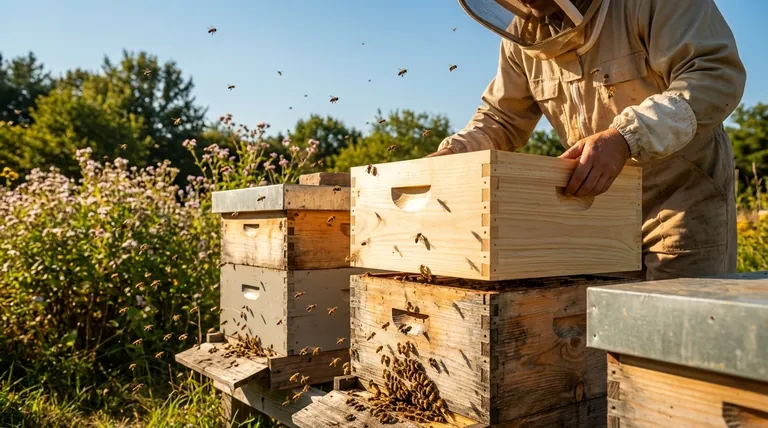Choosing the right weather to add a honey super is about hive health, not just beekeeper convenience. Performing this task on a warm, sunny day ensures the bees are actively foraging and more likely to accept and utilize the new space. This simple timing decision minimizes stress on the colony and aligns with their natural workflow.
The core principle is this: your goal is to add space with the least possible disruption. Good weather makes the colony receptive and reduces the risks associated with opening the hive, while poor weather can actively harm the bees by causing temperature shock and defensive behavior.

The Impact of Ideal Weather Conditions
Adding a super on a warm, sunny day with temperatures ideally above 60°F (15°C) works with the bees' natural instincts, not against them. This creates a cascade of positive effects for the colony.
Encouraging Rapid Acceptance
When bees are actively foraging, the hive is bustling with activity. Introducing a new super during this time means they are more inclined to immediately investigate, clean, and begin building comb in the new space.
The scent of incoming nectar and the urgent need for storage space encourages them to expand upward without hesitation.
Aligning with Peak Foraging Activity
A sunny day means a strong nectar flow. The workforce is outside the hive, reducing internal congestion and making them less focused on defending the nest from an intrusion.
This external focus makes your work inside the hive go much more smoothly and with significantly less disruption to the colony's daily operations.
Reducing Colony Stress
A calm, warm day makes the bees far less defensive. With many foragers out of the hive, you are dealing with a smaller, more placid population.
This makes the experience safer and less stressful for both you and the bees, preserving the calm temperament of the colony.
The Risks of Adding a Super in Poor Weather
Ignoring the weather and opening the hive on a cold, rainy, or windy day can introduce significant and unnecessary risks to the colony's health and productivity.
The Danger of Chilling the Brood
This is the most critical risk. The brood nest, where larvae and pupae develop, is kept at a constant temperature of around 95°F (35°C).
Opening the hive in cold or windy weather causes a rapid loss of this vital heat. Adding a large, empty super on top creates a massive new space that the bees must expend huge amounts of energy to warm up. This can chill, and even kill, the developing brood.
Increased Colony Defensiveness
On a poor weather day, the entire bee population is inside the hive. They are not busy with foraging and are on high alert for threats.
Opening the hive under these conditions is a major disturbance. The bees will be highly defensive, making the work unpleasant and increasing the chances of you being stung.
Wasted Bee Energy
Even if the brood isn't fatally chilled, the colony must divert significant energy to reheating the hive and the new empty super.
This is energy that could have been used for drawing out wax foundation, foraging, or tending to the queen. Adding a super in cold weather can temporarily set the colony's progress back.
Making the Right Choice for Your Goal
Your decision should always be guided by the principle of "do no harm." Use the weather as your primary indicator for when to act.
- If your primary focus is rapid honey production: Add the super on the first warm, sunny day of a strong nectar flow to ensure the bees draw it out and fill it immediately.
- If your primary focus is minimizing colony stress: Wait for a calm, warm day with minimal wind, even if it means delaying by a day or two, to ensure the least disruption.
- If you're facing a long stretch of bad weather but the hive is full: Add the super during the warmest, calmest window you can find, and work as quickly as possible to minimize heat loss.
By syncing your management tasks with the weather, you partner with your bees' natural rhythm and set them up for a healthy, productive season.
Summary Table:
| Weather Condition | Impact on Bees | Recommended Action |
|---|---|---|
| Warm & Sunny (>60°F/15°C) | Bees are foraging; colony is calm and receptive. | Ideal time to add a super for rapid acceptance. |
| Cold, Rainy, or Windy | Risk of brood chilling; bees are defensive and stressed. | Avoid opening the hive; wait for better conditions. |
Ensure your apiary's success with the right equipment. HONESTBEE supplies durable, high-quality beekeeping supplies and equipment to commercial apiaries and distributors through our wholesale-focused operations. Protect your investment and maximize your honey yield—contact our experts today to discuss your apiary's needs!
Visual Guide

Related Products
- Langstroth Honey Bee Box Hive Boxes for Different Depths
- High-Efficiency Diamond Maze Bee Escape for Clearing Supers
- Australian Langstroth Beehive Boxes for Beekeeping Wholesales
- Portable Bee Mating Hive Boxes Mini Mating Nucs 8 Frames for Queen Rearing
- HONESTBEE Professional Entrance Bee Feeder Hive Nutrition Solution
People Also Ask
- Why do you need two bee hives? Boost Your Apiary's Success with Smart Risk Management
- How should hive boxes be aligned after reassembly? Ensure a Perfect Seal for Hive Health
- What is the purpose of the boxes in a Langstroth hive? A Guide to Modular Beekeeping Success
- What are the sizes of supers available in a standard hive? A Guide to Deep, Medium, and Shallow Boxes
- What is the best time to inspect a hive? Optimize for Bee and Beekeeper Safety



















